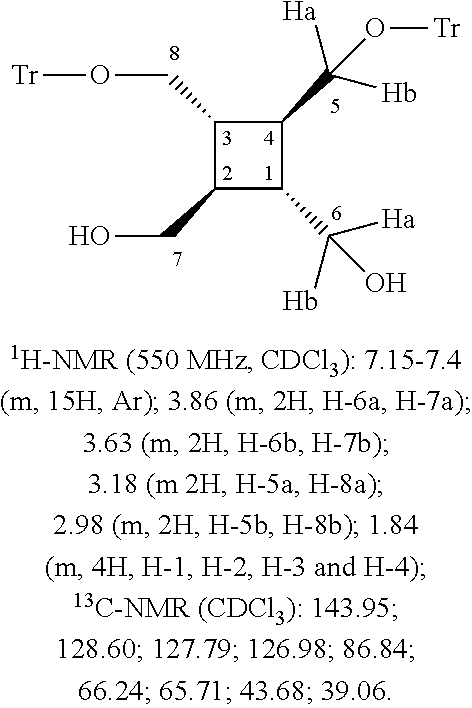Ligands and catalyst systems for hydroformylation processes
a technology of hydroformylation and catalyst systems, which is applied in the direction of hydrocarbon preparation catalysts, physical/chemical process catalysts, organic compounds/hydrides/coordination complexes, etc., can solve the problems of undesired by-product formation and adversely affect the economic viability of the process
- Summary
- Abstract
- Description
- Claims
- Application Information
AI Technical Summary
Benefits of technology
Problems solved by technology
Method used
Image
Examples
example 1
Preparation of the Novel Ligands According to the Invention
a) Preparation of all-trans-1,2-bis[bis-(3,5-xylyl)phosphinomethyl]-3,4-bis(trityloxymethyl)-cyclobutane
[0030]88 mg (0.5 mmol) of all-trans-1,2,3,4-tetra(hydroxymethyl)cyclobutane were dissolved in 3 ml of anhydrous pyridine and, at 0° C., 251 mg (0.9 mmol) of trityl chloride were added with intense stirring. The reaction mixture was kept at 0° C. overnight with stirring. Then, it was added to 10 ml of water and extracted with ethyl acetate (3×5 ml), then dried with MgSO4 and evaporated to dryness in a rotary evaporator.
[0031]The crude product was separated off by chromatography (silica gel). (Eluent:ethyl acetate:hexane 1:3→2:3→ethyl acetate:methanol 95:5).
[0032]The main product obtained was 114 mg (34% of theory) of all-trans-1,2-bis(hydroxymethyl)-3,4-bis(trityloxymethyl)cyclobutane.
[0033]
[0034]In a manner known in the art, the two OH-groups of this compound are tosylated and reacted with LiP(3,5-xylyl)2 to yield all-tran...
example 2
Hydroformylation Corresponding to the Process According to the Invention
[0037]In 4 ml of dried and degassed tert-butyl methyl ether, 16 mmol of all-trans-1,2,3,4-tetra[bis-(3,5-xylyl)phosphinomethyl]-cyclobutane are reacted under argon with [Rh(CO)2(acac)](8 mmol).
[0038]The resulting solution is injected into an autoclave under argon and flushed with a CO:H2-1:1 mixture. Via a side arm, a solution of 1 ml of allyl alcohol in 15 ml of ethanol is then added and the reaction is carried out at a pressure of 40 bar and a temperature of 120° C. This gives 97% of theory of HBA+HMPA in a ratio of ca. 14:1 (selectivity HBA / HMPA=93.3%).
example 3
Comparative Hydroformylation Experiments
[0039]These experiments are conducted in a 60 ml autoclave under argon at a temperature of 65° C. and a pressure of p=20 bar of synthesis gas (CO / H2=1:1). The reaction time is 120 mins.
[0040]A solution of the respective phosphine ligand (2 equivalents or 8.6×10−5 mole) in 15 grams of dry degassed toluene is added to [Rh(CO)2acac] (1 equivalent or 4.3×10−5 mole) in the autoclave. The autoclave is pressurized at 20 bar, then heated to 65° C. and the allyl alcohol (3.5 ml) is injected. After 120 mins, the gas uptake is completed and the autoclave is cooled. The resulting solution is analyzed by gas chromatography to determine the reaction products 4-hydroxyl-butyraldehyde (HBA) and 3-hydroxy-2-methylpropionaldehyde (HMPA). The selectivity is determined by the ratio of the product peak area (HBA) vs. the side product peak area (HMPA). The results are summarized in Table 1:
[0041]
TABLE 1Comparative hydroformylation experimentsSelectivityPhosphine li...
PUM
| Property | Measurement | Unit |
|---|---|---|
| pressure | aaaaa | aaaaa |
| temperature | aaaaa | aaaaa |
| temperature | aaaaa | aaaaa |
Abstract
Description
Claims
Application Information
 Login to View More
Login to View More - R&D
- Intellectual Property
- Life Sciences
- Materials
- Tech Scout
- Unparalleled Data Quality
- Higher Quality Content
- 60% Fewer Hallucinations
Browse by: Latest US Patents, China's latest patents, Technical Efficacy Thesaurus, Application Domain, Technology Topic, Popular Technical Reports.
© 2025 PatSnap. All rights reserved.Legal|Privacy policy|Modern Slavery Act Transparency Statement|Sitemap|About US| Contact US: help@patsnap.com



